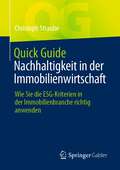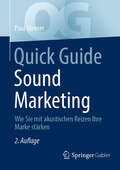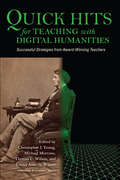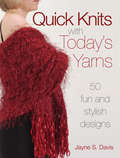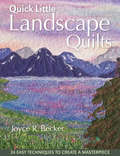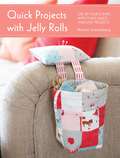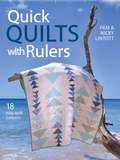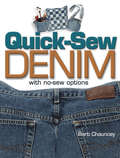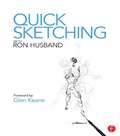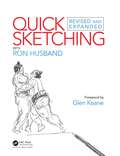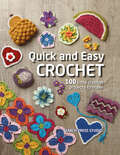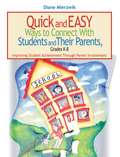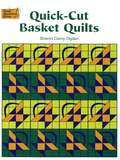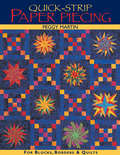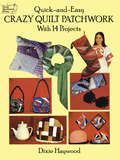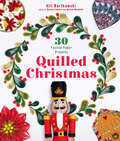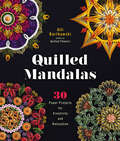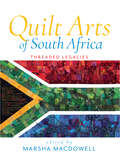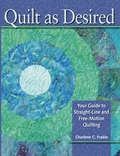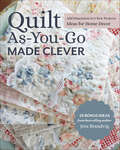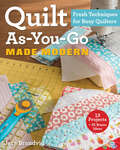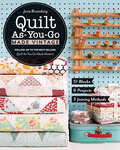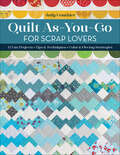- Table View
- List View
Quick Guide Nachhaltigkeit in der Immobilienwirtschaft: Wie Sie die ESG-Kriterien in der Immobilienbranche richtig anwenden (Quick Guide)
by Christoph StraubeDieses Buch erklärt, was die ESG-Kriterien Umwelt, Soziales und Governance für die Immobilienbranche bedeuten und wie Unternehmen nachhaltiges Wirtschaften in der Praxis umsetzen können. Der Autor erläutert anschaulich die Auswirkungen in verschiedenen Bereichen, etwa in der Projektentwicklung, der Investitionsplanung, bei Maklern oder im Gebäudemanagement. Darüber hinaus wirft er einen fokussierten Blick auf digitale Lösungen bei der Umsetzung von ESG-Anforderungen und erläutert warum das Thema in Zukunft ganz oben auf die Agenda von Immobilienunternehmen rücken muss
Quick Guide Sound Marketing: Wie Sie mit akustischen Reizen Ihre Marke stärken (Quick Guide)
by Paul SteinerDieses Buch ist eine kompakte Einführung in das Thema Sound Marketing. Unternehmen stehen heute vor der Herausforderung, ihre Markenwerte gezielt über möglichst viele Sinne zu kommunizieren, um sich explizit vom Wettbewerb zu differenzieren und Konsumenten langfristig an ihre Marke zu binden. Marketingverantwortlichen, die ihrem Unternehmen bzw. ihren Marken ein unverwechselbares (akustisches) Profil geben wollen, liefert der Autor wichtige Ansatzpunkte für die akustische Gestaltung von Marken, die anhand von Beispielen veranschaulicht werden. Zur Veranschaulichung werden die akustischen Marken von Audi, Deutsche Telekom, Intel, Lufthansa, Nokia, Siemens und Wiener Linien analysiert. Die zweite Auflage wurde komplett überarbeitet und u.a. um Ausführungen zur akustischen Reizaufnahme und zum Sound Design in der Automobilindustrie ergänzt. Der Inhalt Wahrnehmung und Wirkung akustischer Reize Markenrecht - Die Klangmarke Sound Marketing Grenzen und Risiken von Sound Marketing Der Autor Dr. Paul Steiner ist promovierter Sozial- und Wirtschaftswissenschaftler. Er erhielt seine Promotion mit Auszeichnung an der Wirtschaftsuniversität Wien, wo er auch den Rudolf Sallinger-Preis für seine Diplomarbeit „Sensory Branding“ gewann. Mit herausragenden Leistungen in den Studiengängen Sozial- und Wirtschaftswissenschaften, Betriebswirtschaft, Musikmanagement und Audio Engineering hat er sich einen Namen gemacht. Seit 20 Jahren leitet er komplexe Projekte in der Bauindustrie, Finanzdienstleistungsbranche und Automobilindustrie. Besonders hervorzuheben ist seine Arbeit am BMW Sound Logo, das 2013 den Red Dot Award gewann. Dr. Steiner ist Autor mehrerer Fachbücher, darunter „Quick Guide Sound Marketing“ (2021) und „Sensory Branding“ (2020).
Quick Hits for Teaching with Digital Humanities: Successful Strategies from Award-Winning Teachers
by Christopher J. Young, Michael Morrone, Thomas C. Wilson, and Emma Annette WilsonQuick Hits for Teaching with Digital Humanities: Successful Strategies from Award-Winning Teachers is an edited collection of 24 articles that aims to introduce faculty, administrators, and staff to ways in which digital techniques from the arts, humanities, and social sciences can be incorporated in the classroom. These techniques can enhance learning and professional development experiences for undergraduate and graduate students and faculty alike. This essential handbook illustrates the breadth of digital humanities across the disciplines with rich examples that bring best practices to life. Anyone who teaches at an institution of higher learning will find entry into new digital paradigms. As the authors share simple and complex ways to introduce digital humanities into the classroom, they expand understandings of what constitutes these current technologies for learning.
Quick Knits With Today's Yarns: 50 Fun and Stylish Designs
by Jane DavisKnitters who want to create today's popular fashions in a minimal amount of time will love this book, with 50 projects that can be completed using just two basic stitches knit and purl. This book explains each technique in easy-to-follow instructions, so that even beginners will be successful in creating these fun and funky pieces! A delicious array of popular yarns in sparkly metallics, "soft fuzzies," cozy chenilles, "eyelash" yarns, and ribbons of every variety are used to create hats, shawls, scarves, purses and covers ups. Many projects feature embellishments such as beads, buttons, tassels and fringes. Sprinkled throughout the book are tidbits on the history of knitting, tips to making easier, and sidebars teaching specific techniques.
Quick Little Landscape Quilts: 24 Easy Techniques to Create a Masterpiece
by Joyce R. BeckerThe prize-winning landscape quilter shares easy tips and time-saving techniques in this guide featuring mini-landscape quilts for all skill levels.In Quick Little Landscape Quilts, Joyce Becker shows you simple ways to work with landscape-themed fabrics to make a quilted wallhanging you'll be proud to show off. This skill-building guide covers a variety of techniques, such as incorporating overlays for perspective; embellishing with machine embroidery; and enhancing designs with inks, pastels, and more. Featured projects range from simple patterns to photo-based designs.
Quick Projects with Jelly Rolls
by Brioni GreenbergIn Quick Projects with Jelly Rolls, author Brioni Greenberg shows you how to use up your scraps with quick and easy projects.Projects include:Winterberry Table RunnerJaunty Button-Down iPad CaseFairytale Pins 'n' Things
Quick Quilts with Rulers: 18 Easy Quilts Patterns
by Nicky Lintott Pam LintottQuick and easy quilt patterns from best selling authors Pam and Nicky Lintott, who turn their attention to quilting with rulers in this fabulous collection of quilt patterns. Cut accurate shapes for quick piecing with these easy-to-follow step instructions and diagrams. Includes 18 stunning quilt designs made using one of three rulers for quick and easy patchwork.
Quick Sew Denim with No Sew Options: With No-sew Options
by Barb ChaunceyDenim stands the test of time, and sewers are always looking for fresh ideas on how to transform denim into decorative items. Now, you can learn how to create unique home and fashion accessories from new and used denim with this resourceful book. It begins with an overview of denim and jean styles, and then reveals all the basic techniques for gluing and sewing. Whether you're using new denim or revamping old jeans, you are shown how to utilize every square inch to create useful and fun designs.
Quick Sketching
by Carl Cheek"Quick sketching" stimulates the artist's ability to rapidly capture a subject's features, expressions, and movements as they are actually happening. A perfect introduction to this invaluable technique, this concise and uniquely organized guide easily helps artists of every capacity explore new ideas and methods for creating powerful, true-to-life works of art.Discover over one hundred masterfully drawn sketches that wonderfully illustrate the accompanying text. An effective path to acquiring the artistic essentials of the human figure and countenance, as well as busy backgrounds, Quick Sketching offers up innovative, workable methods for quickly--and beautifully--drawing: * adults* children * animals * interiors * portraits * landscapes . . . and more!Affordably priced and sure to be viewed and reviewed again and again, Quick Sketching is a worthy addition to the library of every artist!
Quick Sketching with Ron Husband: Revised And Expanded
by Ron HusbandQuick sketching is the best technique you can use to stay finely tuned and to keep those creative juices flowing. To keep your sense of observation heightened, and to sharpen your hand-eye coordination, an animator needs to constantly draw and sketch. Quick Sketching with Ron Husband offers instruction to quick sketching and all its techniques. From observing positive and negative space and learning to recognize simple shapes in complex forms to action analysis and using line of action, this Disney legend teaches you how to sketch using all these components, and how to do it in a matter of seconds. On top of instruction and advice, you’ll also see Ron’s portfolio of select art representing his growth as an artist throughout the years. Watch his drawings as he grows from a young, talented artist, to a true Disney animator. Follow him as he goes around the world and sketches flamenco dancers, football players, bakers, joggers, lions, tigers, anyone, and anything. As if instruction and inspiration in one place weren’t enough, you’ll find a sketchbook included, so you can flip from Ron’s techniques and work on perfecting basic shapes. Or take your book on the road, read Ron’s advice, sketch away, capture the world around you.
Quick Sketching with Ron Husband: Revised and Expanded
by Ron HusbandQuick Sketching with Ron Husband offers instruction to quick sketching and all its techniques. From observing positive and negative space and learning to recognize simple shapes in complex forms to action analysis and using line of action, this Disney legend teaches you how to sketch using all these components, and how to do it in a matter of seconds. Watch his drawings as he grows from a young, talented artist, to a true Disney animator. Follow him as he goes around the world and sketches flamenco dancers, football players, bakers, joggers, lions, tigers, anyone, and anything. Key Features Get tips on quick sketching from a Disney legend who has animated or supervised some of your favourite recent Disney movies like The Fox and the Hound, The Little Mermaid, and Beauty and the Beast. Features artist’s guide and handbook which provides instruction while chronicling the author’s growth as an artist. Quickly try out Husband’s instructions and tips as you learn them in a sketchbook at the back of the book. This new edition re-emphasizes the four basic shapes and how important it is to recognize them in fast action. Stressing the importance of observation and the vital part this discipline plays in sketching.
Quick and Easy Crochet: 100 Little Crochet Projects to Make
by Search Press StudioThis gorgeous book brings together 100 of the top crochet projects from the bestselling Twenty to Make series. With contributions from five top crochet designers and bestselling authors, these fabulous designs are quick and easy to make, and include stylish purses and hats, cute teddy bears, flowers, hearts and festive decorations. Whether you are on a budget and want to make a quick and quirky gift for a friend, or wish to indulge in a special treat for yourself, you will discover a treasure trove of ideas within this book that you simply won’t be able to resist.Projects have been taken from the following titles in the Twenty to Make series:Mini Christmas Crochet by Val PierceCrocheted Bears by Val PierceCrocheted Flowers by Jan OllisCrocheted Granny Squares by Val PierceCrocheted Beanies by Frauke KiedaischCrocheted Purses by Anna NikipirowiczCrocheted Hearts by May CorfieldGranny Square Flowers by May CorfieldPreviously published as 100 Little Crochet Gifts to Make“From ornamental flowers to variations on the granny square, hats to holiday ornaments, Quick and Easy Crochet contains a smorgasbord of patterns—100 of them—for a variety of purposes and skill levels.” —Booklist“I have reviewed quite a few of the Twenty to Make books and they are fabulous. Each one has twenty simple projects that not only give fantastic results but also aid in your learning of new crafts. So to get them in one BIG book, for me, is absolutely divine . . . a bright and colourful book filled with inspiration.” —Postcard Reviews
Quick and Easy Ways to Connect with Students and Their Parents, Grades K-8: Improving Student Achievement Through Parent Involvement
by Diane MierzwikThe research is indisputable. The more involved parents are with their child’s education, the more successful that child will be in school. Therefore, finding ways as a teacher to reach out to students and their parents is crucial in improving academic performance.Quick and Easy Ways to Connect With Students and Their Parents, Grades K-8 provides strategies to enrich the classroom environment, motivate students, and improve communication with parents. Supplying numerous sample forms, documents, and letters that teachers can use or adapt for their own purposes, author Diane Mierzwik offers simple, classroom-tested methods for building relationships with students and their parents.Designed for both beginning and experienced teachers, this hands-on guidebook includes information on:• Facilitating constructive parent-teacher conferences• Preparing for Back-to-School nights• Reaching out to uninvolved parents• Talking to parents about troubled students• Motivating even the most difficult students• Using e-mail as a communication tool and other time-saving tipsThe activities, suggestions, and techniques in this book can help any teacher make a substantive impact on the lives of students.
Quick-Cut Basket Quilts
by Sharon Cerny OgdenWho would have thought the humble basket could have so many exciting variations? Patterns for a dozen different blocks, plus an array of striking layouts, are at hand in this easy-to-follow how-to guide by veteran quilting instructor and designer Sharon Cerny Ogden. You'll find simple instructions, diagrams, and time-saving quick-cutting methods that will help you piece together your own heirloom-quality basket quilt in a fraction of the time it ordinarily takes to assemble a quilt top.Motifs include the traditional Cake Stand and its 5-patch relations, the Grape Basket and Fruit Basket; patterns with a touch of applique such as Grandmother's Basket and Basket of Flowers; three kinds of Flower Pots; plus four more attractive patterns. In addition to complete instructions for each block, the author provides you with a wealth of helpful advice about adapting a design to different sizes, instructions for quick-cutting and piecing right triangles, and handy cutting charts for each of the basket blocks.Whether you're a novice or an expert, this excellent, practical guide will be an inspiring addition to your personal library.
Quick-Strip Paper Piecing: For Blocks, Borders & Quilts
by Peggy MartinLearn how to speed up your paper piecing with this innovative technique and create radiant quilts.Paper piece your way to fast, accurate quilts! “Quick-strip” whiz Peggy Martin combines the accuracy of paper piecing, the speed of strip piecing, and an incredible eye for color to create quilts that seem to glow from within. Discover for yourself this fun, easy, nearly mistake-proof variation on a theme.• 17 block patterns plus two borders, based on traditional designs - all paper pieced for speed and accuracy• 4 complete quilt projects include “Midnight Garden,” “Millennium Star,” “New York Beauty,” and “Rainbow Galaxy”• Complete instructions for Peggy’s quick-strip technique, plus fabric selection, pattern preparation, and finishing touches• Get inspired by a gallery of bright, colorful quick-strip quilts• A great introduction to paper piecing for beginners, and experienced paper piecers will love it, too!
Quick-and-Easy Crazy Quilt Patchwork: With 14 Projects
by Dixie HaywoodWhen the Victorian needlecrafter found herself with odd pieces of fabric and free time on her hands, the result was often a colorful, beautifully stitched crazy quilt. At the zenith of their popularity between 1870 and 1900, these richly colored and lushly textured quilts were often made of fine but unlaunderable pieces of material and were seldom padded for warmth. Charming but impractical, Victorian crazy quilts were regarded, at best, as whimsical fabric collages.In this practical guide, quilt designer and author Dixie Haywood takes a contemporary approach to making crazy quilts. Her clear instructions and diagrams — along with modern, quick-and-easy piecing methods and valuable information on practical fabrics and padding — lead quilters through fourteen crazy quilt patchwork projects that are fast and fun.An introductory chapter offers "A Short Look at the Victorian Crazy Quilt," followed by sections on contemporary quilting and stitching methods. A final "project" section lets quilters select from a variety of items — pincushions, potholders, reversible toaster covers, lined shopping bags, Christmas wreaths and stockings, shirts, caftans, tablecloths — and, of course, a contemporary crazy quilt.
Quiet Beauty
by Kendall H. Brown David M. CobbQuiet Beauty: Japanese Gardens of North America is an extraordinary look at the most beautiful-and serene-gardens in the United States and Canada. Most Japanese garden books look to the gardens of Japan. Quiet Beauty explores the treasure trove of Japanese gardens located in North America. Featuring an intimate look at twenty-six gardens, with numerous stunning color photographs of each, that detail their style, history, and special functions, this book explores the ingenuity and range of Japanese landscaping.Gardens include: Japanese Tea Garden in Golden Gate Park, San Francisco, California Nitobe Memorial Garden, University of British Columbia, Vancouver, British Columbia Japanese Garden, Fort Worth Botanic Garden, Texas Garden of the Pine Winds, Denver Botanic Gardena, Colorado Japanese Garden, Montréal Botanical Garden, Québec Tenshin'en (The Garden of the Heart of Heaven), Museum of Fine Arts, Boston, Massachusetts Roji'en (Garden of Drops of Dew), The George D. and Harriet W. Cornell Japanese Gardens, The Morikami Museum and Japanese Gardens, Delray Beach, Florida Japanese Friendship Garden of Phoenix, Margaret T. Hance Park, Arizona Garden of the Pine Wind, Garven Woodland Garden, Hot Springs, Arkansas
Quilled Christmas: 30 Festive Paper Projects
by Alli BartkowskiCelebrate the season with 30 colorful and charming paper-quilling projects for Christmas decorations, ornaments, gift tags, greeting cards, and more. Christmas is the perfect time to brighten your home and delight friends and family with handmade gifts and decorations. In these 30 beautiful holiday-themed quilling projects, Alli Bartkowski explains how to roll, shape, and glue paper strips into eye-catching framed art, a handsome nutcracker figurine, a lovely snowflake ornament, colorful jewelry, and more. Each project is designed for a specific skill level, and you&’ll find a comprehensive introduction and step-by-step photos of the essential techniques needed to create basic shapes, elegant typography, and dazzling linear art.
Quilled Mandalas: 30 Paper Projects for Creativity and Relaxation
by Alli BartkowskiTwo hot trends—paper quilling and mandala-themed crafting—come together in 30 new projects from the co-owner of the popular company, Quilled Creations. Alli Bartkowski explains the basic tools and techniques of quilling, from curling and crimping the paper to forming scrolls, strips, and rolls. Detailed step-by-step photos show all the shapes needed for the projects, which come in an assortment of 4&”, 6&”, and 8&” designs with projects for the beginner, intermediate, and advanced quiller. Feel the calm and serenity created by the repetitive motions as you quill a Crimson Flower, Sunset, Snowflake, Peacock, and other vivid, beautiful mandalas.
Quilt Arts of South Africa: Threaded Legacies
by Marsha MacDowellIn the southernmost region of the African continent, women have been piecing together materials—textile construction techniques commonly used in quilting— to create bed coverings throughout the history of the San and Khoi peoples. From the late seventeenth century through the early nineteenth century, an influx of Dutch, French, Indian, and British military personnel, traders, miners, and missionaries came to South Africa, bringing with them their own cultural traditions, including making and using quilts. Today, the making of quilts in South Africa is flourishing.Quilt Arts of South Africa stitches together the history, production, and significance of quilt making from its earliest appearance in the continent's southernmost region to the twenty-first century. With input from curators, linguists, art historians, activist artists, and folklorists, this book presents disparate yet connected inquiries into a wide-ranging history of the quilt. These perspectives connect a rich expressive art to place, showing how the quilting traditions in South Africa together reflect a unique cultural history and natural landscape.Itself pieced together from diverse voices, Quilt Arts of South Africa offers glimpses into the histories and meanings of quilting in South Africa.
Quilt As Desired: Your Guide to Straight-Line and Free-Motion Quilting
by Charlene FrableThis book comes to the rescue of quilters everywhere by finally addressing the most dreaded phrase in quilting instruction - quilt as desired. Packed with 150 step-by-step photos, detailed instructions and expert insight into thread selection, marking techniques and simple binding, each chapter meet your desire to continually grow as a quilter. Using straight-line and free-motion techniques to complete six feature projects, this revolutionary guide will help you take your quilting to new heights.
Quilt As-You-Go Made Clever: Add Dimension in 9 New Projects; Ideas for Home Decor
by Jera BrandvigJera Brandvig’s signature quilt-as-you-go method is back with brand new techniques and ideas! Create pretty projects using small, manageable pieces of fabric that can be made into different shapes and sizes from a creative and fresh perspective. The follow up to best-sellers Quilt-as-you-go Made Modern and Quilt-as-you-go Made Vintage, this book introduces how to quilt individual circles, hexagons, and easy 3D quilt blocks. Also, learn to add extra creative flair with embellishments such as lace and ribbon to your quilt. Once you’ve created your treasured masterpiece, enjoy learning Jera’s tips for how to tastefully display quilts as elegant home decor. Create beginner and precut-friendly quilts in multiple styles and sizes Learn various techniques such as making reversible quilts with folded circles or hexagons, making 3-dimensional flower blocks, and embellishing with ribbons and lace Includes special chapter showing Jera’s ideas for using quilts as home decor
Quilt As-You-Go Made Modern: Fresh Techniques for Busy Quilters
by Jera BrandvigLearn to create modern quilts more quickly and easily than ever with this popular method, featuring thirteen projects and twenty-five bonus ideas. Do you believe rules were meant to be broken? If so, this improvisational quilt-as-you-go technique is for you. Instead of dealing with precise paper patterns and cutting measurements, you&’ll learn how to piece fabric onto small, manageable batting blocks. Let your creative juices flow as you quilt directly on the blocks (not the whole quilt!), whether in large abstract zigzags or small structured stitches. After the blocks have been joined, all you need to do is add backing fabric and binding, and—voila—it&’s finished! A modern approach to quilting that&’s fresh, fun, and simpler than it sounds; it will change the way you quilt (for the better) Great for moms or anyone with a busy schedule—these thirteen projects are easy to transport because they make it simple to pick up where you left off Go your own way: This method allows you to use a pattern or improvise, creating a wide variety of design options Save money! Learn how to finish your own quilts without the use of a longarm professional &“Quilting is easier than ever with Jera Brandvig&’s modern spin on the popular quilt-as-you-go technique.&” —Modern Quilts Unlimited&“Quilt-as-you-go (QAYG) is one of those techniques that every quilter is curious about trying, but can be daunting as the process is so different to the traditional process of making a quilt top and then quilting it. . . . The book introduces the technique very thoroughly, so you can clearly understand the difference between traditional piecing and quilting and QAYG. Then there&’s a great selection of gorgeous quilts that are sure to appeal to the modern quilter. A must if you&’ve ever thought about trying QAYG and haven&’t had a clue where to start.&” —Make Modern Magazine
Quilt As-You-Go Made Vintage: 51 Blocks, 9 Projects, 3 Joining Methods
by Jera BrandvigFrom the bestselling author of Quilt As-You-Go Made Modern—learn to create vintage quilts more quickly and easily than ever. Get comfortable with basic piecing and machine quilting - one block at a time! Best-selling author Jera Brandvig is back, this time with a romantic take on her quilt-as-you-go designs. Try your hand at nine projects, including an elegant sampler with fifty-one mix-and-match blocks. For quilt as-you-go enthusiasts, Jera shares three optional joining methods, including her new technique that makes your quilt reversible! No matter how busy your schedule, you can set attainable goals and practice quilting patchwork blocks in small, manageable pieces. · Timeless, classic quilts for busy folks! Easily finish quilts on your home machine with quilt-as-you-go · Learn a new way to quilt-as-you-go that decorates the back of your quilt in pretty patchwork squares · Mix and match fifty-one blocks to assemble a one-of-a-kind quilt!&“Whilst the first book focused on improvisational techniques in a modern style, this one is about using vintage fabrics in classic block designs. There are useful sections on tools and supplies, working with batting, and choosing your fabrics. Each project is laid out in an easy-to-follow fashion that is packed with photos and diagrams. Overall, a well-considered books that is a delight to look through with a warm, encouraging tone of voice.&”—Popular Patchwork
Quilt As-You-Go for Scrap Lovers: 11 Fun Projects; Tips & Techniques; Color & Piecing Strategies
by Judy GauthierScrappy quilt-as-you-go made easy Stack your fabric stash on your worktable –– it's time to create scrap quilts! Turn fabric stashes into unique scrap quilts with Judy Gauthier's quilt-as-you-go method (QAYG). You will find yourself using scraps that you never thought you would use again while discovering several QAYG techniques and projects. The ultimate DIY technique, quilt-as-you-go means you control the whole process from the first stitch to the last. If you're someone who has several WIPs (works in progress), or you need time-saving quilting hacks, this book of fast and easy QAYG is for you. 11 all-new scrappy quilts made using Judy’s quilt-as-you-go method Use every last scrap of fabric! QAYG is the ultimate DIY sewing technique Get a handle on color selection for truly sensational scrappy quilts
